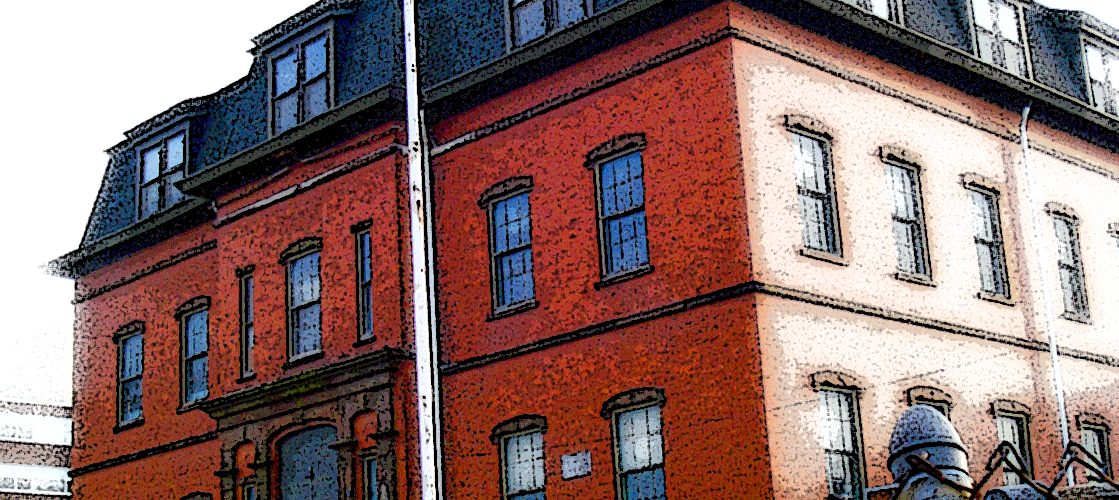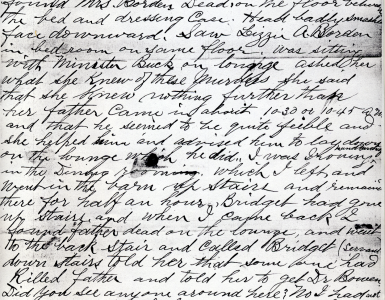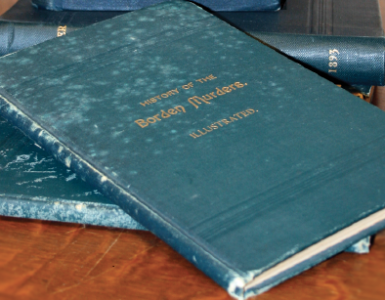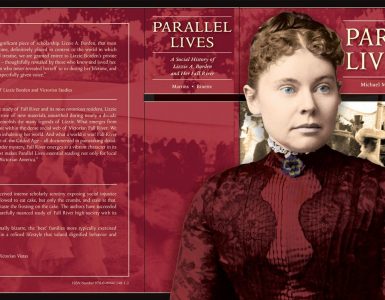by Shelley Dziedzic
First published in April/May, 2008, Volume 5, Issue 2, The Hatchet: Journal of Lizzie Borden Studies.
With the recent discovery of the photograph of a wistful little Lizzie Borden, aged perhaps nine years, there is much renewed interest in her life and childhood influences. As with any person accused of a shocking crime, both acquitted and found guilty, biographers yearn for information on the early years. What childhood events might make a person into a murderer later on in life? How could one who looked so innocent possibly have been guilty of such a grisly double homicide?
It is a frustrating fact that there is not more known about the early years of Lizzie Borden. Hopefully, diaries and letters will be found and published one day that will reveal more about the missing years of her life. But surely one area of her life that holds a fascination is her grammar school years.
Lizzie was ready for grammar school at a very opportune time in the history of Fall River, Massachusetts, education. Before the Civil War, a quality education within the city was an unevenly distributed entity. Schoolhouses from before 1850 had been cheaply built with few conveniences. The city was divided into nine school districts in 1818 that increased later to fourteen. The three-man General School Committee had urged the abolishment of the district system for years, although it remained in place until 1864. The problem with the system was apparent—the most densely populated districts erected the best schools and had the money to hire the most qualified teachers in the country, whereas the sparsely populated districts could not manage to provide the very basics and resorted to poorly paid, unqualified teaching staff and severely substandard facilities.
One of the earliest school reports of 1842 condemns the conditions of the city’s schools, which included a lack of books and blackboards, discipline problems, and lack of attendance. Female teachers during this time made $16.25 per month in the summer, and had to be unmarried. Men in the winter term made $62.50 per month.
Improvements began in 1848 with the establishment of an evening school, a high school in 1849, a school for factory children in 1862, and, in 1865, the almshouse was used as a detention and instruction school for truants. But it was in 1865, at war’s end, when an important man took the reins of the troubled school system. He was Rev. Daniel W. Stevens, a Harvard graduate who devoted his energies toward fitting out the schools with much-needed supplies. He also appointed the first truant officer and set to work updating school furnishings. Malcolm Tewksbury continued the good work the following year through 1872, followed by William Connell, who held the position until 1894.
In the two decades from 1850 to 1870, the population of the city jumped by 16,000—it was plain that many new schoolhouses would have to be built to accommodate the pupils. The very first of what would become a wave of new school building began with the Morgan Street School, which was built and opened by the summer term of 1868. Lizzie Borden was then eight years old. Later, the school would be renamed after the city’s fourth mayor, Nathaniel Briggs Borden (mayor in 1857 and followed in that position by Josiah C. Blaisdell from 1858-60).
The Morgan Street School was built in the Second Empire style, which is Italianate style with a Mansard roof. Dormer windows, a square or round tower, decorative brackets, molded cornices, similar to Italianate detail on windows and doors, are all elements of this popular style. It is the first true style of the Victorian era in the United States (roughly 1860-1900), which was most popular in the Northeast and Midwest, but rarely seen in the South. It was also known as the General Grant style, as it was used during the Grant administration for public buildings. Second Empire was named for the reign of Napoleon III (1852-1870), who undertook a major building campaign to transform Paris into a city of grand boulevards and monumental buildings that were copied throughout Europe and North America. Napoleon’s famous project was the enlargement of the Louvre (1852-1857), where he reintroduced the Mansard roof, developed in 1600s Renaissance France by Francois Mansart. This style traveled from France to England to America. The Morgan Street School would later lose its distinctive cupola on the roof.
The Bordens were living on Ferry Street at the time of Lizzie’s primary school years. Andrew had remarried, to Abby Durfee Gray, and now Lizzie had a new stepmother. It would have been a bit of a walk for Lizzie to travel from Ferry Street up to Morgan Street. She probably went east up Columbia Street to South Main, and on to Morgan Street, a few blocks southeast, the most direct route. By 1872, Lizzie’s family had moved to Second Street and she still attended the Morgan Street School for grammar school until age 14.
Mr. Horace Benson, a principal of the school, had this to say about Lizzie’s student days: “as a pupil she was an average scholar, neither being exceptionally smart nor noticeably dull. She was subject to varying moods, and was never fond of her stepmother. She had no hesitation in talking about her, and in many ways, showed her dislike of her father’s second wife.” When Mr. Benson lived on Second Street, he came to know Abby Borden and said she was “a kindly hearted, lovable woman, who tried, but ineffectually to win the love of the stepdaughters.”
Mr. Benson boarded at 84 Second Street from 1891 to 1903, moving to 44 Morgan Street, where he stayed until 1909.
Interviewed by the Boston Herald, Lizzie’s friends had this to say:
As a child she was of a very sensitive nature, inclined to be non-communicative with new acquaintances, and this characteristic has tenaciously clung to her all through life, and has been erroneously interpreted. . . . At the usual age she was sent to the Morgan street school, embracing primary and grammar grades. Her school days were perhaps unlike most girls in this lack of affiliation with her fellow pupils. As a scholar she was not remarkable for brilliancy, but she was conscientious in her studies and with application always held a good rank in her class. She entered the high school when about 15 or 16 years old. . . . She was, however, a girl with anything but an enthusiastic idea of her own personal attainments. She thought people were not favorably disposed toward her and that she made a poor impression.
Today, the windows of the old brick schoolhouse on Morgan Street stare like vacant eyes over the playground fringed with weeds. It was only a year ago when colorful flowers cut from construction paper festooned these same windows. There had been white snowflakes in the winter, and tulips in the spring. However, it was in June 2007 that the school, a fixture since 1868, closed its doors forever as an institution of learning. With low test scores and severely strained facilities, the Board of Education decided it was for the best. Another wave of new school building has swept the city over the past five years, as it had in 1865, and now the sound of skipping feet and childish laughter is heard no more at the N.B. Borden School on Morgan Street.
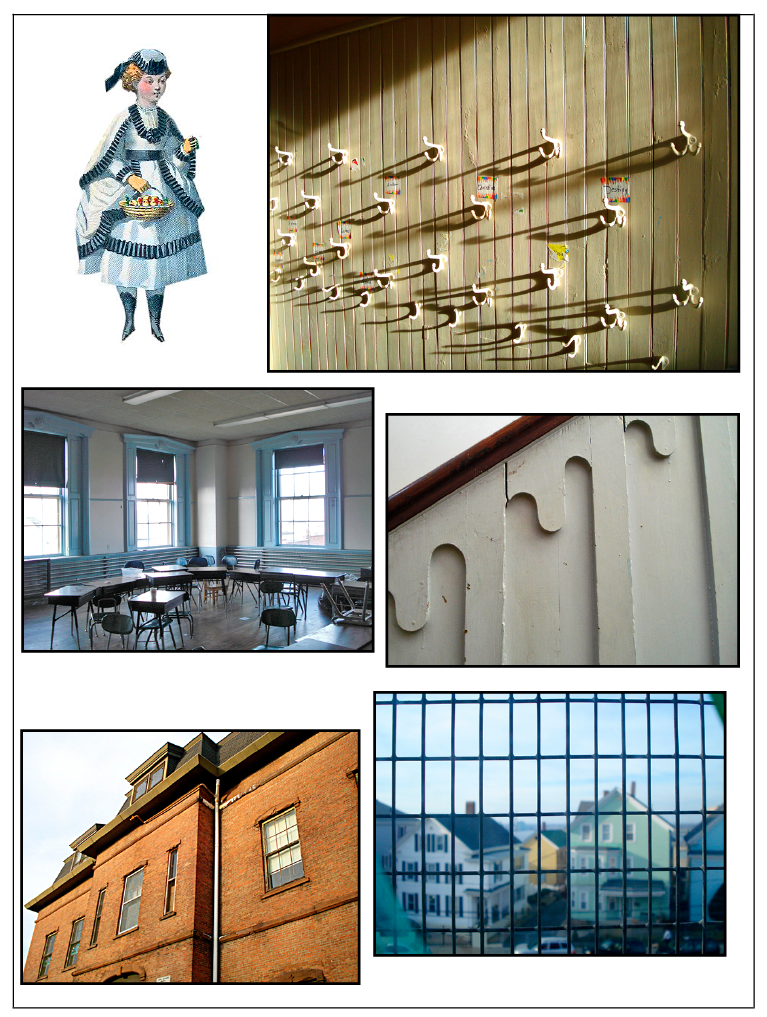
On an autumn visit, the sight of the darkened, empty classrooms was haunting as only a building once full of life, then silenced, can be. The school office was shrouded in quiet—papers scattered everywhere; the principal’s desk sitting forlorn and expectant. Above all the windows and doors inside are the most exquisite Renaissance Revival cornices. In some rooms, the rich walnut has been painted over with cheap institutional paint. On the first floor, the little cafeteria tables stand ready for students’ lunches that will come no more. Across the hall, a classroom had been converted into a gymnasium. A basketball net swings lazily in a shaft of pale sunlight and dust motes. Every floor of the three story building is identical—a large square center hall as large as a room, with two spacious classrooms opening off each side. A winding staircase at both the front and the back of the building rises to the next level. Its coiling newel post finial has been touched by thousands of little sticky hands over the 139 years, the walnut is worn and smooth and cool to the touch. The climb from the second to the third floor reveals a fancy scrolling pattern in the stairwell, and the windows on the highest floors are carefully covered with thick wire screens.
Everywhere are the reminders of long ago—the wooden plank floors, beadboard-backed bookcases, brass cloakroom hooks, and dozens of those wonderful pediments over the doors. On the top floor, a dumb waiter stands poised in its chute with its doors agape, waiting now forever for an eager hand to hoist the ropes. A seagull swoops by the high, screened window that shows a most amazing view of the Braga Bridge and Taunton River. Everywhere, the hasty retreat of the staff and students can be seen in the debris on the floor—papers flung willy-nilly, boxes and desks shoved into corners. It is the end of an era.
The playground is also silent. Heavy granite uprights remain to support fencing that no longer exists—only the running rust shows the spot where it once had been. In the shadows of an autumn afternoon, you might just see the serious face of a little girl under a straw hat. She is carrying her tin lunch pail and sitting alone in the schoolyard.
The Board of Education will be turning the school over to the City of Fall River. Its fate is unknown. The building at 43 Morgan Street is on the list of Registered Places in Bristol County. There are no plans to tear it down.
My thanks to Tim McCluskie of the Board of Education Facilities Department for allowing this visit to the N.B. Borden Morgan Street School and to Stefani Koorey, who accompanied me into the past on one golden autumn afternoon in 2007.
Sources:
B.M.C. Durfee High School (Fall River, MA) Historic Slide Collection. The Keeley Library http://www.sailsinc.org/Durfee/fallriver.htm#schools
Fenner, Henry M. History of Fall River. NY: F.T. Smiley Publishing Company, 1906.
Giza, Patricia. A Guidebook to Fall River’s National Register Properties. The Office of Historic Preservation for The City of Fall River, Massachusetts, 1984.
Kent, David. The Lizzie Borden Sourcebook. Boston: Branden Publishing Company, Inc., 1992.
McCluskie, Timothy (Director, Board of Education Facilites). 2007 interview by Shelley Dziedzic.
Rebello, Leonard. Lizzie Borden Past and Present. Fall River: Al-Zach Press, 1999.


